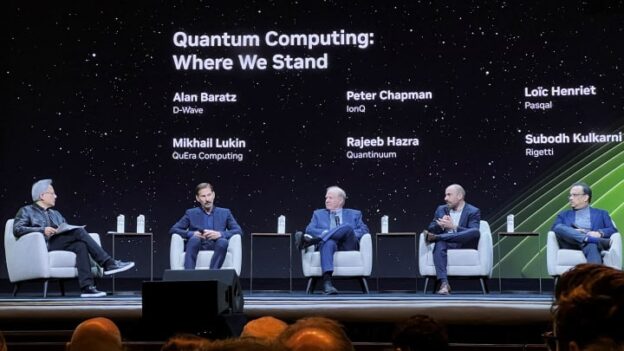Researchers in China have unveiled a 105-qubit quantum processor that can solve in minutes a quantum computation problem that would take billions of years using the world’s most powerful classical supercomputers. The result sets a new benchmark for claims of so-called “quantum advantage”, though some previous claims have faded after classical algorithms improved.
The fundamental promise of quantum computation is that it will reduce the computational resources required to solve certain problems. More precisely, it promises to reduce the rate at which resource requirements grow as problems become more complex. Evidence that a quantum computer can solve a problem faster than a classical computer – quantum advantage – is therefore a key measure of success.
The first claim of quantum advantage came in 2019, when researchers at Google reported that their 53-qubit Sycamore processor had solved a problem known as random circuit sampling (RCS) in just 200 seconds. Xiaobu Zhu, a physicist at the University of Science and Technology of China (USTC) in Hefei who co-led the latest work, describes RCS as follows: “First, you initialize all the qubits, then you run them in single-qubit and two-qubit gates and finally you read them out,” he says. “Since this process includes every key element of quantum computing, such as initializing the gate operations and readout, unless you have really good fidelity at each step you cannot demonstrate quantum advantage.”
At the time, the Google team claimed that the best supercomputers would take 10::000 years to solve this problem. However, subsequent improvements to classical algorithms reduced this to less than 15 seconds. This pattern has continued ever since, with experimentalists pushing quantum computing forward even as information theorists make quantum advantage harder to achieve by improving techniques used to simulate quantum algorithms on classical computers.
Recent claims of quantum advantage
In October 2024, Google researchers announced that their 67-qubit Sycamore processor had solved an RCS problem that would take an estimated 3600 years for the Frontier supercomputer at the US’s Oak Ridge National Laboratory to complete. In the latest work, published in Physical Review Letters, Jian-Wei Pan, Zhu and colleagues set the bar even higher. They show that their new Zuchongzhi 3.0 processor can complete in minutes an RCS calculation that they estimate would take Frontier billions of years using the best classical algorithms currently available.
To achieve this, they redesigned the readout circuit of their earlier Zuchongzhi processor to improve its efficiency, modified the structures of the qubits to increase their coherence times and increased the total number of superconducting qubits to 105. “We really upgraded every aspect and some parts of it were redesigned,” Zhu says.
Google’s latest processor, Willow, also uses 105 superconducting qubits, and in December 2024 researchers there announced that they had used it to demonstrate quantum error correction. This achievement, together with complementary advances in Rydberg atom qubits from Harvard University’s Mikhail Lukin and colleagues, was named Physics World’s Breakthrough of the Year in 2024. However, Zhu notes that Google has not yet produced any peer-reviewed research on using Willow for RCS, making it hard to compare the two systems directly.
The USTC team now plans to demonstrate quantum error correction on Zuchongzhi 3.0. This will involve using an error correction code such as the surface code to combine multiple physical qubits into a single “logical qubit” that is robust to errors. “The requirements for error-correction readout are much more difficult than for RCS,” Zhu notes. “RCS only needs one readout, whereas error-correction needs readout many times with very short readout times…Nevertheless, RCS can be a benchmark to show we have the tools to run the surface code. I hope that, in my lab, within a few months we can demonstrate a good-quality error correction code.”
“How progress gets made”
Quantum information theorist Bill Fefferman of the University of Chicago in the US praises the USTC team’s work, describing it as “how progress gets made”. However, he offers two caveats. The first is that recent demonstrations of quantum advantage do not have efficient classical verification schemes – meaning, in effect, that classical computers cannot check the quantum computer’s work. While the USTC researchers simulated a smaller problem on both classical and quantum computers and checked that the answers matched, Fefferman doesn’t think this is sufficient. “With the current experiments, at the moment you can’t simulate it efficiently, the verification doesn’t work anymore,” he says.
The second caveat is that the rigorous hardness arguments proving that the classical computational power needed to solve an RCS problem grows exponentially with the problem’s complexity apply only to situations with no noise. This is far from the case in today’s quantum computers, and Fefferman says this loophole has been exploited in many past quantum advantage experiments.

Classical computers race to catch up with quantum advantage
Still, he is upbeat about the field’s prospects. “The fact that the original estimates the experimentalists gave did not match some future algorithm’s performance is not a failure: I see that as progress on all fronts,” he says. “The theorists are learning more and more about how these systems work and improving their simulation algorithms and, based on that, the experimentalists are making their systems better and better.”
Quantum computers extend lead over classical machines in random circuit sampling





